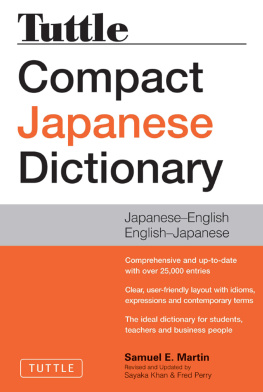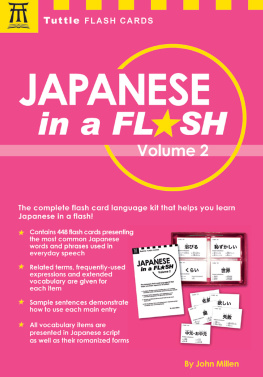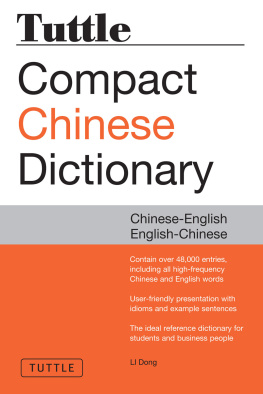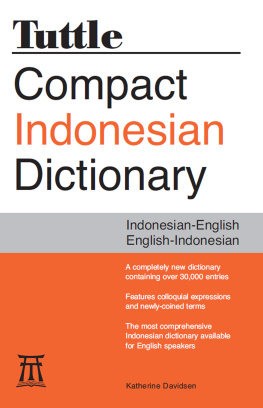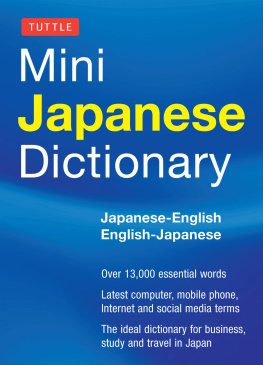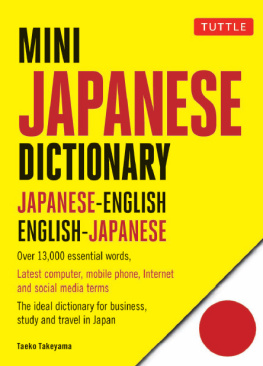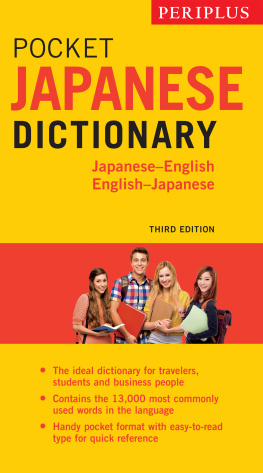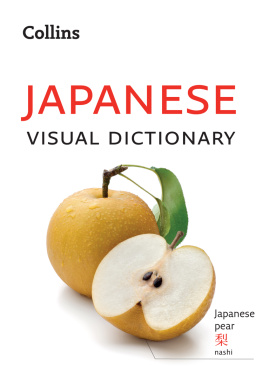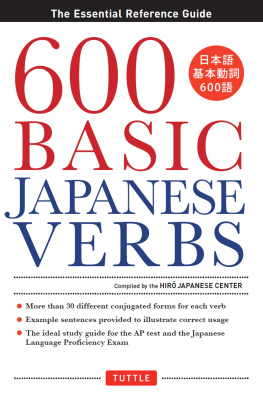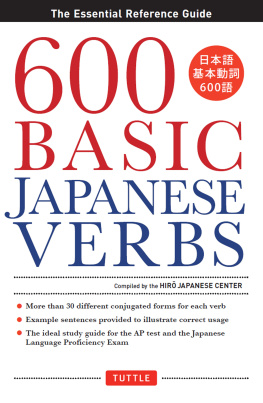Published by Periplus Editions (HK) Ltd. www.tuttlepublishing.com 2007 by Periplus Editions (HK) Ltd
This revised edition 2011 by Periplus Editions (HK) Ltd All rights reserved. No part of this publication may be reproduced or utilized in any form or by any means, electronic or mechanical, including photocopying, recording, or by any information storage and retrieval system, without prior written permission from the publisher. Library of Congress Control Number: 2011921097
ISBN: 978-1-4629-1082-3 (ebook) This title was first published by Charles E. Tuttle Publishing in 1994 as Martin's Concise Japanese Dictionary (ISBN 0-8048-1912-2).
| Tel: (81) 3 5437-0171 | Tel: 1 (802) 773-8930 |
| Fax: (81) 3 5437-0755 | Fax: 1 (802) 773-6993 |
| sales@ tuttle.co.jp | info@tuttlepublishing.com |
| www.tuttle.co.jp | www.tuttlepublishing.com |
Asia Pacific Berkeley Books Pte. Ltd. 61 Tai Seng Avenue #02-12 Singapore 534167 Tel: (65) 6280-1330 Fax: (65) 6280-6290 inquiries@periplus.com.sg www.periplus.com 14 13 12 11
7 6 5 4 3 2 1 1104MP Printed in Singapore TUTTLE PUBLISHING is a registered trademark of Tuttle Publishing, a division of Periplus Editions (HK) Ltd.
Dear Reader: In order to view all colored text and non-English text accurately, please ensure that the PUBLISHER DEFAULTS SETTING on your reading device is switched to
ON.
Dear Reader: In order to view all colored text and non-English text accurately, please ensure that the PUBLISHER DEFAULTS SETTING on your reading device is switched to
ON.
This will allow you to view all non-English characters and colored text in this book. Tuttle Publishing Samuel E. Martin is the author of numerous books and papers on Japanese and Korean, including the definitive A Reference Grammar of Japanese and A Reference Grammar of Korean . Sayaka Khan has a BSC (Biology, 2000) from Waseda University. She has worked as a translator and interpreter for companies in various industries, such as patent offices, science think tanks, pharmaceutical firms, film productions, game companies, etc. She has established a translation corporation with her husband, Afaque Khan.
Fred Perry has a BA (History, 1956) from Yale University as well as an MBA from St Sophia University, Tokyo (1984). He arrived in Japan in 1956, and continues to live there today. He has worked as a market researcher and consultant. Traveling throughout Japan as part of his job has provided the opportunity to learn about the local dialects spoken in different parts of the country.
GRAMMAR This dictionary differs from other dictionaries in a number of ways. The verb forms are cited primarily in the normal polite form ( ms u [ ] ), for that is what the beginning student will most often hear and practice using at the end of sentences.
Other common forms are also given, such as the plain nonpast ( u [ ] or ru [ ] ) and the gerund ( te [ ] or de [ ] ). The nonpast forms, whether plain or polite, refer to general, repeated, or future situations (does or will do); they are also used for situations that started in the past but continue on into the present, such as I have been staying here since the day before yesterday ( ototi kara koko ni ims u [] ), or that have a result that lasts, such as I have gotten married ( kekkon sh i te ims u [] ), another way to say I am married. The past forms (did) are easily made: for the polite past, change ms u [ ] to msh i ta [ ] , and for the plain, take the gerund and change its final e to a , with the result being ta [ ] or da [ ] . The plain nonpast form for the [ noun ] ds u [] it is [a matter of] is d [ ] , but that is replaced by no [ ] or na [ ] when the expression modifies a following noun. The choice of no [ ] or na [ ] depends on a number of factors that are described in grammars and textbooks. This dictionary gives the appropriate form in parentheses in many cases.
The polite past of the [ noun ] dsu [] is dsh i ta [ ] , the plain past is dtta [ ] (even when the nonpast would change to na [] or no [] ), and the gerund is d [ ] ). The form ni [ ] , in addition to its many uses as a particle (to, at, for), also functions as a form of ds u [ ], the infinitive in the meaning so as to be, as in jzu ni narimsh i ta n [ ] has gotten good at it. The infinitive form of verbs ( i or e ) in spoken Japanese is mainly used to form compounds, and many nouns are derived from infinitives by a change of accent, e.g., yasum [] vacation or work break from yasmi [] to rest). The common nouns and infinitives derived in this manner are included in the Japanese-English section of this dictionary. The polite negative nonpast forms of verbs are made by changing ms u [ ] to masn [ ] and the past to masn deshita [ ] . They are run together as if they are one word; the plain nonpast forms end in nai [ ] and the plain past forms end in nakatta [ ] .
The negative gerund is nide [ ] , as in Isognaide kudasai [] Dont go so fast, but before mo [ ] or wa [ ] , it is usually nkute [ ] , as in Isognak u te wa dam des u [] Youve got to go fast and Tabnak u te mo i des u [] We dont have to eat. In the English-Japanese section, the citation form for verbs is the English infinitive (to do minus the to ), whereas most Japanese-English dictionaries use the plain nonpast as a citation form; do not confuse that with the English infinitive. This dictionary gives most English translations as third-person singular (does), but Japanese verbs nonspecific with reference to person. Adjectives are cited in the plain forms -i [-] ( samui [] its cold) for they are often used before a noun, where the plain form is most common. The polite forms appropriate at the end of a sentence end in -i des u ( sami des u [] its cold). (Do not confuse -i des u [-] and -ktta desu [-] with the [ noun ] dsu [()] , for which the past is [ noun ] dshita [()] .) The infinitive (so as to be) ends in -ku [-], as in smuku narimshita [ ] it turned cold. (Do not confuse -i des u [-] and -ktta desu [-] with the [ noun ] dsu [()] , for which the past is [ noun ] dshita [()] .) The infinitive (so as to be) ends in -ku [-], as in smuku narimshita [ ] it turned cold.
There are many adverbs derived from the adjective infinitive, such as hyaku [, ] quickly or early. And the -ku [-] combines with arimasn [] (plain form ni [ ] ) to make the negative: smuku arimasn [] it isnt cold, smuku ni h ni wa [] on days that are not cold. The past of the negative is -ku arimasn desh i ta [- ] (plain past -ku nkatta [-] ). The gerund of the adjective (being or is and) ends in -k u te [-] , and the negative gerund, as in -ku nk u te [-] . But many Japanese words that translate as English adjectives belong to a different class of words and are treated more like nouns. For that reason they are sometimes called adjectival nouns or nominal adjectives, but you may want to think of them simply as na words, since they attach the word na (that/who is ) when they modify a following noun: hey ga shzuka des u [] the room is quiet, shzuka na hey des u [] it is a quiet room.
As with nouns, the nonpast form of na words is dsu [ ] (plain form d [] or nothing, but replaced by no [] or na [] before a noun), and the past is dsh i ta [ ] (plain form dtta [ ] ). The negative is ja arimasn [ ] (plain form ja ni [ ] ), the negative past is ja arimasn deshita [ ] (plain form ja nkatta [ ] ); all are usually run together with the preceding word to make one long phrase. The gerund is d [ ] , as in hey ga shzuka de krei des u [ ] the rooms are quiet and clean, and krei de shzuka na hey [] rooms that are quiet and clean. The infinitive ni [ ] means so as to be as in shzuka ni narimsh i ta [ ] became quiet or ly as in shzuka ni asonde ims u [] is playing quietly. In a similar manner, Japanese nouns are often followed by some form of ds u [ ] (often called the copula), replacing a more specific predicate. When the predicate is a verb or an adjective, the role of the noun is marked by a particle.

